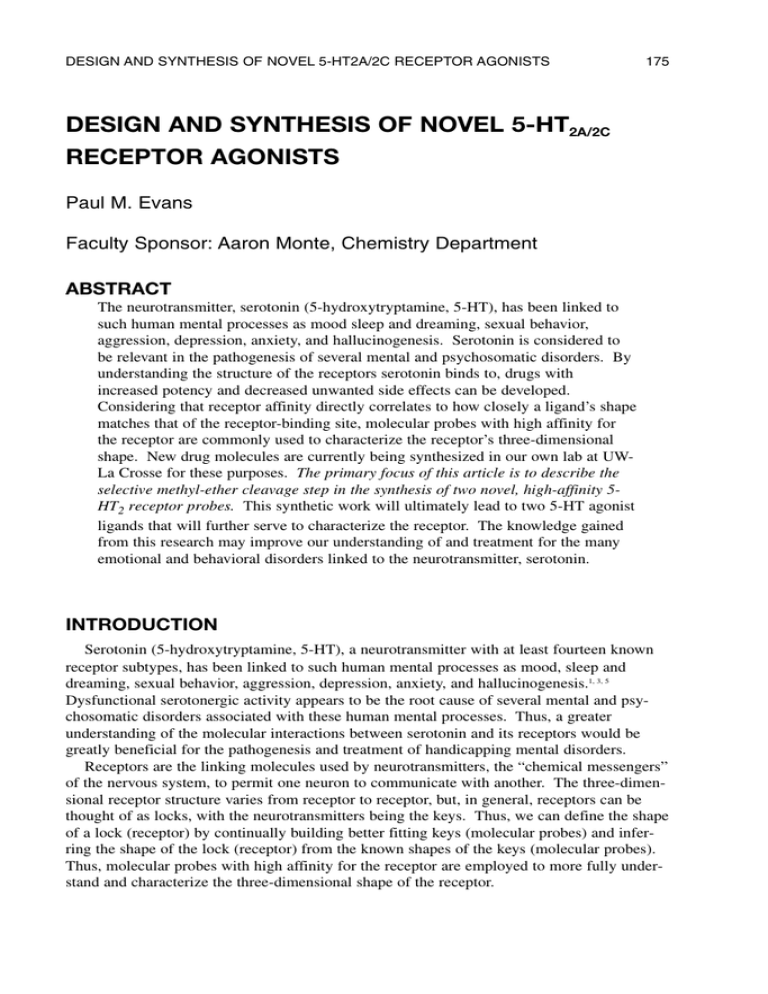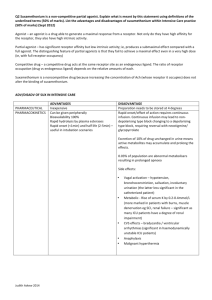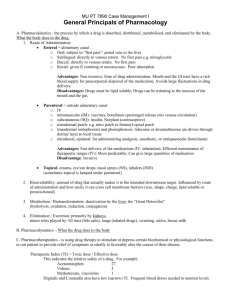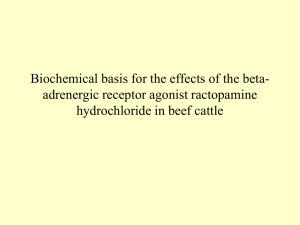DESIGN AND SYNTHESIS OF NOVEL 5-HT RECEPTOR AGONISTS Paul M. Evans
advertisement

DESIGN AND SYNTHESIS OF NOVEL 5-HT2A/2C RECEPTOR AGONISTS 175 DESIGN AND SYNTHESIS OF NOVEL 5-HT2A/2C RECEPTOR AGONISTS Paul M. Evans Faculty Sponsor: Aaron Monte, Chemistry Department ABSTRACT The neurotransmitter, serotonin (5-hydroxytryptamine, 5-HT), has been linked to such human mental processes as mood sleep and dreaming, sexual behavior, aggression, depression, anxiety, and hallucinogenesis. Serotonin is considered to be relevant in the pathogenesis of several mental and psychosomatic disorders. By understanding the structure of the receptors serotonin binds to, drugs with increased potency and decreased unwanted side effects can be developed. Considering that receptor affinity directly correlates to how closely a ligand’s shape matches that of the receptor-binding site, molecular probes with high affinity for the receptor are commonly used to characterize the receptor’s three-dimensional shape. New drug molecules are currently being synthesized in our own lab at UWLa Crosse for these purposes. The primary focus of this article is to describe the selective methyl-ether cleavage step in the synthesis of two novel, high-affinity 5HT2 receptor probes. This synthetic work will ultimately lead to two 5-HT agonist ligands that will further serve to characterize the receptor. The knowledge gained from this research may improve our understanding of and treatment for the many emotional and behavioral disorders linked to the neurotransmitter, serotonin. INTRODUCTION Serotonin (5-hydroxytryptamine, 5-HT), a neurotransmitter with at least fourteen known receptor subtypes, has been linked to such human mental processes as mood, sleep and dreaming, sexual behavior, aggression, depression, anxiety, and hallucinogenesis.1, 3, 5 Dysfunctional serotonergic activity appears to be the root cause of several mental and psychosomatic disorders associated with these human mental processes. Thus, a greater understanding of the molecular interactions between serotonin and its receptors would be greatly beneficial for the pathogenesis and treatment of handicapping mental disorders. Receptors are the linking molecules used by neurotransmitters, the “chemical messengers” of the nervous system, to permit one neuron to communicate with another. The three-dimensional receptor structure varies from receptor to receptor, but, in general, receptors can be thought of as locks, with the neurotransmitters being the keys. Thus, we can define the shape of a lock (receptor) by continually building better fitting keys (molecular probes) and inferring the shape of the lock (receptor) from the known shapes of the keys (molecular probes). Thus, molecular probes with high affinity for the receptor are employed to more fully understand and characterize the three-dimensional shape of the receptor. 176 EVANS Our research is specifically concerned with the characterization of the 5-HT2A/2C G-proteincoupled receptor subtypes. Although some structure-activity relationship (SAR) studies exist regarding the interaction of serotonin with these receptors, a complete description of the three-dimensional structure of the agonist binding site remains elusive.3, 4 The research presented here focuses on a selective methyl-ether cleavage step in the synthesis of two novel 5-HT2A/2C agonist probes. O O O NH 2 NH 2 NH 2 Br O A: 2C-B Br Br O O B: tetrahydrobenzodipyran C: hexahydrobenzodipyran Early SAR studies led to the development of molecules with high receptor affinity exemplified by the phenylisopropulamine, 2C-B (A).5 Such molecules provided the backbone for further SAR investigation and identified the three main structural components necessary for optimal agonist activity. The structural components were the protonated amine, 2 carbons from the aromatic ring, the methoxy groups located at the 2- and 5-positions, and the hydrophobic 4-substituent (Fig. 1).5, 4 Lone pair electrons on 2- and 5-position ring substituents O NH3 Hydrophobic substituent at the 4-position Br Protonated amine, two carbon atoms from ring O Fig. 1. Main Structural Components Necessary for Optimal 5-HT2 Agonist Activity A rigid analogue approach, utilizing high affinity compounds such as A as the building blocks initiated the next sequence of SAR studies and led to the development of molecular probes, B and C. Compound B was found to be one of the most potent, site-specific 5HT2A/2C agonists ever developed.4 The two H-bond donors in the receptor preferentially bonded to the electron pair directed anti to the side chain on the 5-position oxygen and to the electron pair in the syn orientation on the 2-position oxygen.4 With the most desirable orientation of the oxygen lone pairs known, compound C began to address the question of how much steric bulk the 5-HT2A/2C receptors could accommodate. Pharmacological assay results for compound C have shown that it is less potent than its smaller analog, B, thus leading to the belief that the larger pyran rings of C decrease its 5-HT2A/2C receptor affinity. DESIGN AND SYNTHESIS OF NOVEL 5-HT2A/2C RECEPTOR AGONISTS 177 With the development of compounds B and C and their respective pharmacological data, another steric factor came into question: Do the two receptor binding pockets corresponding to the 2,3-heterocycle and 5,6 heterocycle accommodate different sized rings, and if so, which pocket is the larger of the two? To answer these questions, agonist molecules with steric hindrances between that of B and C needed to be developed. This requirement was met with the hybrid (furanyl/pyranyl) molecules D and E. O O NH 2 NH 2 Br Br O D: 2-(4-bromo-2,3-dihydrofurano[2,3-g] chroman-9-yl)ethylamine O E : 2-(9-bromo-2,3-dihydrofurano[2,3-g] chroman-4-yl)ethylamine CHEMISTRY The asymmetric structure of compounds D and E presented a significant synthetic challenge relative to the symmetrical difuran B and dipyran C because the two heterocyclic moieties must be constructed independently. A number of synthetic approaches were available in the construction of D and E. After exploring each of these possibilities, one approach (Scheme 1) involving the selective cleavage of the methyl ether group from 3, has ultimately yielded the key intermediate 7, a necessary precursor to molecular probes D and E. In pursuing this synthetic strategy, three reagents with reported selective ether cleavage capabilities, BBr3, BCl3, and B-bromo-9-BBN were investigated for their appropriateness in effecting the transformation of methyl ether 3 to phenolic compound 4. The results ranged from complete cleavage of both ether groups to mixtures containing various quantities of all possible cleavage products. Compound 4 was eventually synthesized in good yield with the reagent, B-bromo-9-BBN, from the selective methyl ether cleavage of compound 3. The mechanism of the cleavage reaction using this specialized reagent is depicted in Scheme 2. CONCLUSIONS AND FUTURE WORK Successful and reproducible production of the phenolic product 4 made possible the synthesis of the key intermediate 7 in good yield. Following this accomplishment, the novel 5-HT2A/2C receptor agonists D and E can be produced readily using a previously established literature procedure.4 These two new molecular probes will provide considerable knowledge concerning the serotonin 5-HT2A/2C receptors and their three-dimensional structures. Specifically, pharmacological assay of those target compounds will reveal the precise locations of more sterically hindered binding sights within the receptor and a more precise understanding of the bonding interactions between agonist and receptor on the atomic level. 178 EVANS Scheme 1: Demethylation of 1-Bromo-2(2,5-dibromo-4-methoxyphenoxy)ethane OCH3 OCH3 + Br2 K2CO3 Br Br acetone CH 2Cl 2 O OH Br 1 2 OCH3 OH Br Br demethylating agent* Br O + Br Br Br O Br Br 3 4 O Br O Br K2CO3 nBuLi Br acetone THF O O Br 6 5 * Demethylating agents investigated: BBr3, BCl3, and B-bromo-9-BBN Scheme 2. Proposed Demethylation Mechanim for B-Bromo-9-BBN H3C O Br Br H3C O B B Br Br + Br Br O Br O Br 3 OH O OH Br B B hydrolysis Br Br + O Br Br O Br + CH3Br 4 DESIGN AND SYNTHESIS OF NOVEL 5-HT2A/2C RECEPTOR AGONISTS 179 EXPERIMENTAL 1-Bromo-2-(4-methoxyphenoxy)ethane (2). A solution of p-methoxyphenol 1 (10.049 g, 0.089 mol) was dissolved in 100 mL of acetone and added to a mixture of 1,2-dibromoethane (35 mL, 0.406 mol), finely powdered anhydrous potassium carbonate (35 g, 0.253 mol), and 300 mL of acetone. The mixture was held at reflux for approximately 140 hours and then cooled and filtered through Celite to remove the potassium carbonate. The volatiles were removed in vacuo, and the remaining residue was taken up in CH2Cl2 and washed with 3 x 25 mL of 2.5 M NaOH, 3 x 25 mL of 1 M HCl, and 50 mL of brine. The organic phase was dried with MgSO4 and filtered through Celite, and the solvent was removed under reduced pressure to yield an orange solid. The solid was purified by first removing the dimer by triturating the solid with a 10% CH2Cl2-90% hexanes solution, and filtering through Celite. Removal of the volatiles under reduced pressure left an off-colored solid. The solid was recrystallized from ethyl acetate-hexanes to give the diether 2 as sheets of translucent crystals. 1-Bromo-2-(2,5-dibromo-4-methoxyphenoxy)ethane (3). To a stirred suspension of the diether 2 in 100 mL of CH2Cl2 was added enough iron fillings to cover one third of the spoon of a microspatula. Bromine (0.0272 mol, 2.1eq) in 50 mL of CH2Cl2 was added dropwise over a period of one hour, and the reaction mixture was stirred for 13 hours at room temperature. The red-brown mixture was washed with 4 x 25 mL of 2.5 M NaOH resulting in a colorless organic phase which was then washed with 3 x 25 mL of 1 M HCl, and brine. The organic phase was then dried with MgSO4 and filtered. The volatiles were removed in vacuo, yielding a white solid. The solid was recrystallized from ethyl acetate-hexanes to give the brominated diether 3 as colorless needles. 2,5-Dibromo-4-(-2-bromoethoxy)phenol (4). A solution of the brominated diether 3 in 75 mL of CH2Cl2 was stirred under nitrogen, and 1.0 M B-bromo-9-BBN (100.0 mL, 0.10 mol) was added dropwise via syringe. The reaction mixture was heated at reflux for 110 hours. The volatiles were removed on the rotary evaporator, and the resulting yellow residue was taken up with ether and cooled in an ice bath. Residual B-bromo-9-BBN was precipitated from the solution by the dropwise addition of 6 mL of 2-aminoethanol and removed by filtration through Celite. The ether solution was washed with 3 x 30 mL of 6 M HCl, and the phenol 4 was extracted into 3 x 25 mL of 2.5 M NaOH. The combined extracts were acidified with 6 M HCl and the organics extracted with 3 x 25 mL of diethyl ether. The organic extracts were washed with brine and dried over MgSO4, followed by filtration through Celite. Volatiles were removed under reduced pressure, and the yellow residue was purified by flash column chromatography using silica gel as the stationary phase and CH2Cl2 as the eluant. Solvent removal gave the demethylated phenol 4 as a white solid. 180 EVANS REFERENCES 1. Buijs, R.M., ed. Chemical Transmission in the Brain. Elsevier: NY, 1982, 25-32. 2. Foye, W.O., ed. Principles of Medicinal Chemistry, Third Edition. Lea & Fibiger: Philadelphia, 1989. 3. Nichols, D.E. “Medicinal Chemistry and Structure-Activity Relationships” In Amphetamine and its Analogs; Cho, A.K.; Segal, D.S.; ed.; Academic Press, Inc.: San Diago, 1994, 3-41. 4. Monte, A.P.; Marona-Lewicka, D.; Parker, M.A.; Mayleben, M.; Mailman, R.B.; Wainscott, B.; Nelson, D.L.; Nickols, D.E. “Dihydrobenzofuran Analogs of Hallucinogens. 3. Models of 4-Substituted (2,5-Dimethoxyphenyl) alkylamine Derivatives with Rigidified Methoxy Groups” J. Med. Chem. 1996, 39, 2953-2961. 5. Restak, R.M. Brainscapes. Hyperion: NY, 1995, 37-50, 55-56, 116-118. ACKNOWLEDGEMENTS University of Wisconsin-La Cross College of Science and Allied Health UW-L Undergraduate Research Grant Program UW-L Chemistry Department Jennifer A. Prescher and Michael S. Whiteside







![Shark Electrosense: physiology and circuit model []](http://s2.studylib.net/store/data/005306781_1-34d5e86294a52e9275a69716495e2e51-300x300.png)